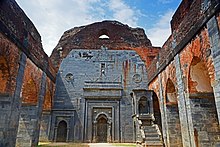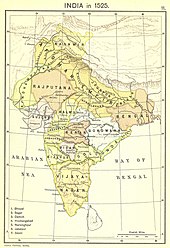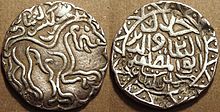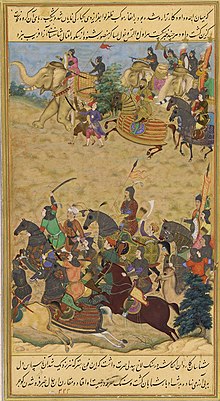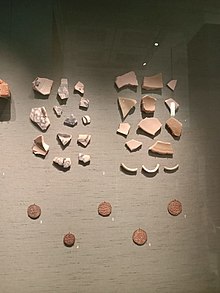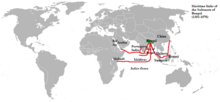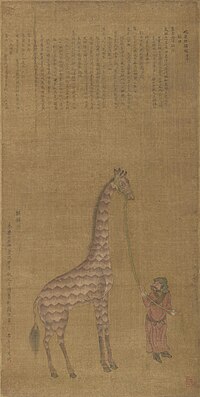Bengal Sultanate
The Bengal Sultanate had a circle of vassal states in the Indian subcontinent, including parts of Odisha in the southwest, Arakan in the southeast,[7] and Tripura in the east.
[8] The Bengal Sultanate controlled large parts of the eastern South Asia during its five dynastic periods, reaching its peak under Jalaluddin Muhammad Shah.
Its raids and conquests reached Nepal in the north, Brahmaputra valley (modern-day Assam) in the east, and Jaunpur and Varanasi in the west.
The Bengal Sultanate was connected to states in Asia, Africa, the Indian Ocean, and Europe through maritime links and overland trade routes.
[30] During the early 15th century, the Ilyas Shahi rule was challenged by Raja Ganesha, a powerful Hindu landowner, who managed to place his son (a convert to Islam), Jalaluddin Muhammad Shah, on the throne.
Francis Buchanan-Hamilton's writings make mention of a manuscript found in the former Bengali capital Pandua which labels Hussain as a native of a village named Devnagar in Rangpur who seized an opportunity to redeem the throne of Bengal that his grandfather, Sultan Ibrahim, had held seventy years prior.
This era is often regarded as the golden age of the Bengal Sultanate, in which Bengali territory included areas of Arakan, Orissa, Tripura, and Assam.
Mughal rule formally began with the Battle of Raj Mahal when the last reigning Sultan of Bengal was defeated by the forces of Akbar.
The following is a partial listing of mint towns:[60] The Sultans had a well-organised army, including cavalry, artillery, infantry and war elephants; and a navy.
Portuguese historian João de Barros opined that the military supremacy of Bengal over Arakan and Tripura was due to its efficient artillery.
In fact, the cavalry could ensure the hold over this country for a period of six months whereas the boats backed by the paiks could command supremacy over the other half of the year.
Since the time of Iwaz Khalji, who first organised a naval force in Islamic Bengal, the war boats played an important role in the political affairs of the country.
A diplomat in the court of Shahrukh Mirza recorded that the Timurid ruler of Herat intervened during the Bengal-Jaunpur conflict after a request from the Sultan of Bengal.
[64] Records from Ming China state that the Yongle Emperor also mediated between Jaunpur and Bengal after the Bengali ambassador in his Peking court complained of the conflict.
[71] In 1532, a Bengali Muslim commander named Turbak invaded Ahom territory with a force comprising 1,000 cavalry, 30 elephants, and numerous guns and cannons.
[84][7] Arakanese rulers replicated the Sultan's governing techniques, including adopting the title of Shah and minting coins in Arabic and Bengali inscriptions.
[95] The apparent vibrancy of the Bengal economy in the beginning of the 15th century is attributed to the end of tribute payments to Delhi, which ceased after Bengali independence and stopped the outflow of wealth.
The expansion of muslin production, sericulture and the emergence of several other crafts were indicated in Ma Huan's list of items exported from Bengal to China.
The testimony of European travelers such as Ludovico di Varthema, Duarte Barbosa and Tomé Pires attest to the presence of a large number of wealthy Bengali merchants and shipowners in Malacca.
[102] Overland trade routes such as the Grand Trunk Road connected Bengal to northern India, Central Asia and the Middle East.
[52] Other European visitors included Niccolo De Conti, Ludovico di Varthema and Caeser Fredrick from the Republic of Venice and Bologna.
[105] Sultan Ghiyasuddin Azam Shah sponsored the construction of madrasas (Islamic theological schools) in the pilgrimage cities of Makkah and Madinah.
[112] Emperor Yongle of China responded by sending ambassadors to Bengal between 1405 and 1433, including members of the Treasure voyages fleet led by Admiral Zheng He.
Men wore white shirts, cotton fabrics of various colors, turbans, sarongs, lungis, dhutis, leather shoes, and belts to wrap their robes on the waist.
There was a class of musicians who would gather by the houses of the rich during dawn and play music; and they would be rewarded with wine, food and money during breakfast hours.
When the Sultan invited Hafez to complete an incomplete ghazal by the ruler, the renowned poet responded by acknowledging the grandeur of the king's court and the literary quality of Bengali-Persian poetry.
Bengali Muslim writers produced translations of numerous Arabic and Persian works, including the Thousand and One Nights and the Shahnameh.
[127][128] The Indian state of West Bengal is home to two of the sultanate's former capitals Gaur and Pandua, as well as several notable structures including a watchtower, fortified walls and mausolea.
According to Perween Hasan in a book edited by Oleg Grabar, the mosques of the Bengal Sultanate have several common features, including pointed arches, multiple mihrabs, engaged corner towers, and terracotta and stone decoration.
An indigenous Islamic mausolea style developed with the Eklakhi Mausoleum, which is the royal tomb chamber of Sultan Jalaluddin Muhammad Shah.

